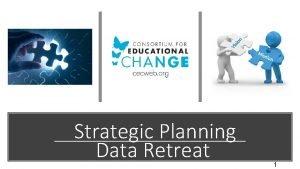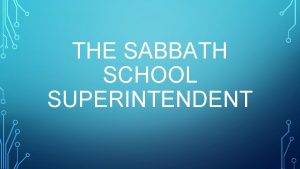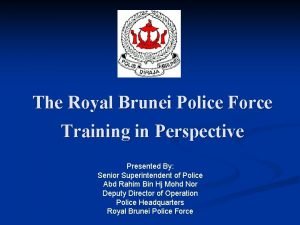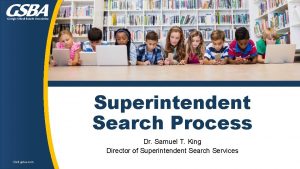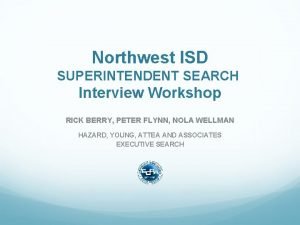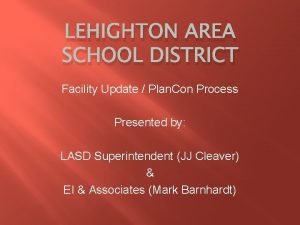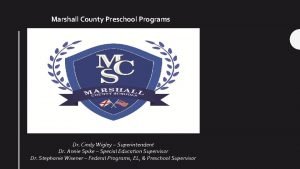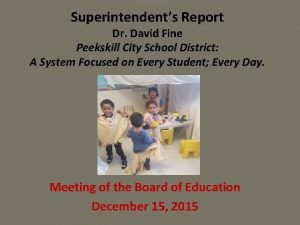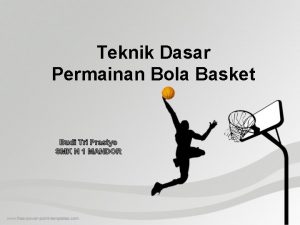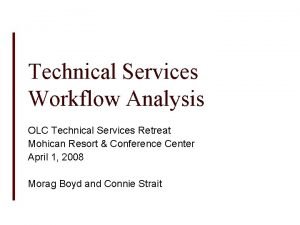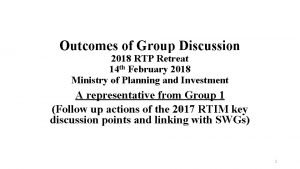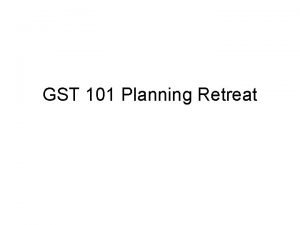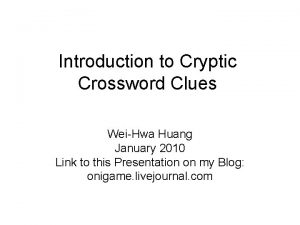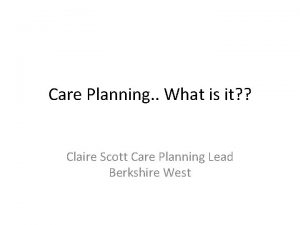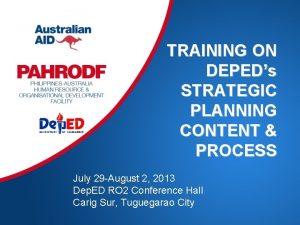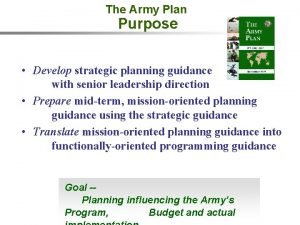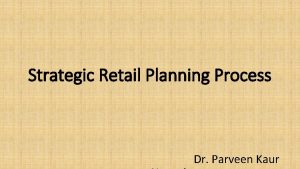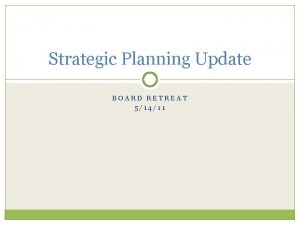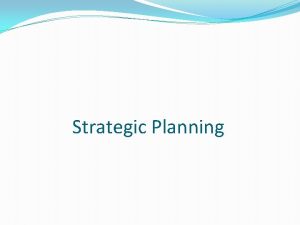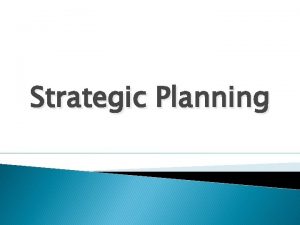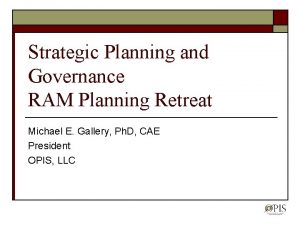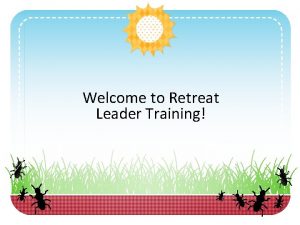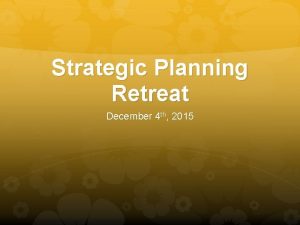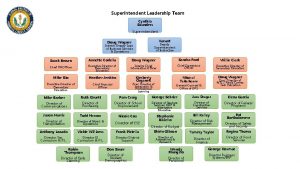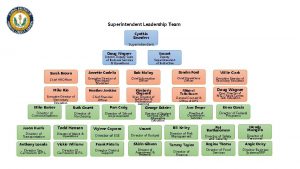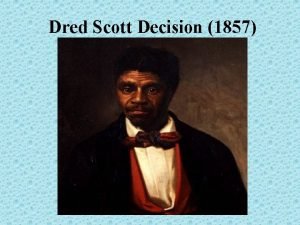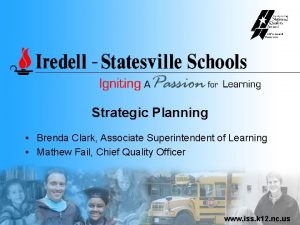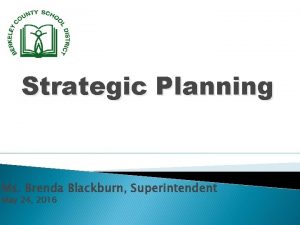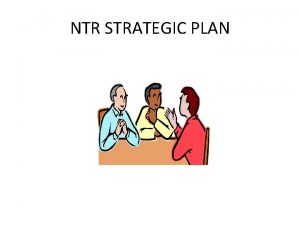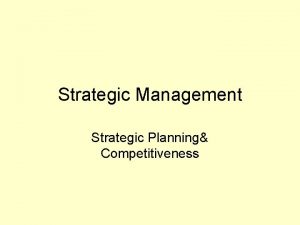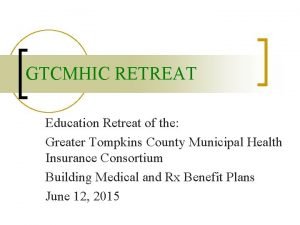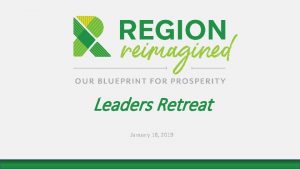Strategic Planning Data Retreat 1 Welcome Superintendent Scott








































- Slides: 40

Strategic Planning Data Retreat 1

Welcome Superintendent Scott Wakeley Who are we and what are we here to do? 2


FOUNDATION OF CONTINUOUS IMPROVEMENT Pillars Guiding Question MISSION What is our fundamental purpose; why do we exist? VISION What must we become in order to accomplish our fundamental purpose? GOALS How will we know if we are making a difference? VALUES How must we behave to achieve our mission, vision and goals?

Strategic Planning Process Where do we want to be? Vision and Mission Stakeholder Input/ Impacts Where are we now? What are we learning? How will we get to where we want to be? Needs Assessment Goal Setting Action Planning Defining Key Areas To Improve Gap Analysis SMART Goals Strategies Best Practice Staff Development Review and Revise Implement Strategies Annual- Formative Multi-Year: Summative Monitor Adjust Improve Adjust Structures &Processes

WHERE DO WE WANT TO BE? HOW DO WE GET FROM WHERE WE ARE TO WHERE WE WANT TO BE? WHERE ARE WE NOW? It is good to have an end to journey toward; but it is the journey that matters in the end. Ursula K. Le. Guin 1999 CONTINUOUS IMPROVEMENT


PART ONE: Determine the current state of the district – Where are we now? State of District Environmental Scan Perceptions Performance Data STRENGTHS WEAKNESSES OPPORTUNITIES THREATS School/ Community Feedback 8

Now I understand COMMON VOCABULARY

DATA RETREAT OUTCOMES • Review our perceptions of what is going well and what are our future challenges. Review others’ perceptions of what is going well and what are our future challenges • Paint a data picture of the district to develop a shared understanding of our performance results. Identify from the reports information that is trending in the right direction and information that may need attention and improvement • Conduct a SWOT analysis to identify our strengths, weaknesses, opportunities and threats. • Preview NEXT STEPS and the Vision Retreat 10

QUALITY STAFF FAMILY/ COMMUNITY ENGAGEMENT RESOURCES Long-range GOALS STUDENT GROWTH & ACHIEVEMENT FINANCIAL FACILITIES TECHNOLOGY CULTURE: • • • LEARNING CONDITIONS TEACHING CONDITIONS LEADING CONDITIONS 11

“See it big, and keep it simple. ” ~Wilfred Peterson

ACTIVITY ONE Part A: 40 minutes Review OUR PERCEPTIONS of what is going well in the district and what our challenges are for the future.

Activity Directions: OUR PERCEPTIONS

Table Team’s Perceptions Most Proud About Greatest Challenges Ahead

ACTIVITY ONE Part B: 40 minutes Review OTHERS’ PERCEPTIONS of what is going well in the district and what our challenges are for the future.

Environmental Scan • Student Surveys • Staff Surveys • Parent Surveys

OTHERS’ PERCEPTIONS: Brainstorm. . . Catergorize. . . Prioritize

Others’ Perceptions STRENGTHS OPPORTUNITIES FOR IMPROVEMENT

Reflection How did your team’s perceptions compare with others’ perceptions? In what ways were they similar? In what ways were they different?

We believe that data, like a mirror, gives us valuable feedback about our systems, our students, and ourselves. ~ Jan O’Neill and Anne Conzemius Building Shared Responsibility for Student Learning, page 41

“Data analysis is just the beginning of accountability…it leads to commitment and a deeper understanding of your district’s priorities and improvement plans. ” ~ Jan O’Neill and Anne Conzemius

Activity Two: 135 minutes • Paint a data picture that describes the current District Performance as to what is going well and what are the challenges ahead. • Introduction of Report Presenters: ü Student Growth and Achievement ü Culture: Learning and Teaching Environment ü Resources: Finance, Facilities

Student Growth & Achievement Trend, Cohort, Comparative, Demographic, Growth. . . Is it a strength? Is it an opportunity?

CULTURE: Learning and Work Environment Trend, Cohort, Comparative, Demographic, Growth. . . Is it a strength? Is it an opportunity?

RESOURCES: Finance, Facilities & Technology Trend, Cohort, Comparative, Demographic, Growth. . . Is it a strength? Is it an opportunity?

Reflection • What did you learn from each report that let’s you know how the DISTRICT is performing? • Performing compared to others. • Performing compared to the past/ • Which are strengths? • Which are opportunities?

Activity Directions • Each presentation is to be approximately 30 minutes with an additional 10 minutes for questions. • Take notes on the participant handout. • Thanks to the Presenters.


PROCESSING THE DATA PRESENTATIONS: 30 min • Each group will process the last of the three reports they hear. • The presenter will be a part of the group. • Each group will present a poster highlighting no more than the top key information trending well and the top key information needing attention of improvement. Teams will post their findings for all to view.

ACTIVITY THREE: Gallery Walk 30 min. Identify IMPACTS • Political • Economical • Social • Demographical • Educational • Technological

ACTIVITY FOUR: 40 minutes Conduct a SWOT analysis • Strengths • Weaknesses • Opportunities • Threats

SWOT ANALYSIS • Strengths • Weaknesses • Opportunities • Threats

• What do we consider to be our weaknesses? • What are we most criticized for or receive the most complaints about? • What do we seem to have a hard time doing well? • What do we consider to be our strengths? • What advantages to do have? • What do others say our strengths are? STRENGTHS OPPORTUNITIES • What opportunities for improvement do we know about but have not addressed? • Where with a little work could we change a weakness into a strengths? WEAKNESSES THREATS • Who or what threatens us the most? • What challenges are coming that we must respond to? • What might block our progress?

Activity Directions: • Examine what you learned today: • Your perceptions of Strengths and Opportunities for improvement • Others’ perceptions of Strengths and Opportunities for improvement • Data and information from the Four Reports that are strengths, weaknesses, opportunities or threats • Impact findings that present opportunities or threats

Activity Directions: • Brainstorm with your table strengths, weaknesses, opportunities and threats. • Copy your list to the SWOT chart and post the chart to share with the whole strategic plan team.

NEXT STEPS • Data Retreat Findings. • All Data Retreat resources on website. • SWOT Analysis • Community Engagement • Encourage feedback participation • Leave name table tents and supplies • READY OURSELVES FOR THE VISION RETREAT

Community Engagement Opportunities

Looking Ahead: Vision Retreat n it o c rt u ns I As se ssm en t Curriculum Coll abo re u t c Stru dule e Sch me Ti ratio n Technology Where are we today? Where do we want to be in the future? How will we be different? 39

How do we want to be different 5 -10 years from now than we are today? 40
 Scott wakeley superintendent
Scott wakeley superintendent Strategic planning vs tactical planning
Strategic planning vs tactical planning David moore superintendent
David moore superintendent Cardinal local schools superintendent
Cardinal local schools superintendent Duties of sabbath school superintendent
Duties of sabbath school superintendent Mauritius police force hierarchy
Mauritius police force hierarchy Gsba superintendent search
Gsba superintendent search 09x117
09x117 Northwest isd superintendent search
Northwest isd superintendent search Lehighton area school district
Lehighton area school district Ryder warren superintendent
Ryder warren superintendent Sabbath school attendance record
Sabbath school attendance record Special feature for sabbath school program
Special feature for sabbath school program Thank you note to building superintendent
Thank you note to building superintendent Southmoreland elementary school
Southmoreland elementary school Dr cindy marshall
Dr cindy marshall Esi hospital kk nagar
Esi hospital kk nagar David fine superintendent
David fine superintendent Proact search
Proact search Hitchcock isd
Hitchcock isd Foot fire dribble
Foot fire dribble Olc technical services retreat
Olc technical services retreat Retreat at rtp
Retreat at rtp Gst 101 form
Gst 101 form Difference between slope decline and slope retreat
Difference between slope decline and slope retreat Vipassana 10 day silent retreat substance abuse
Vipassana 10 day silent retreat substance abuse Physician burnout retreat
Physician burnout retreat With the order reversed perversely crossword clue
With the order reversed perversely crossword clue Synthesis retreat cost
Synthesis retreat cost Why do prince prospero and his followers retreat
Why do prince prospero and his followers retreat Dhanyawad slide
Dhanyawad slide Welcome welcome this is our christmas story
Welcome welcome this is our christmas story Dr claire scott
Dr claire scott Strategic fit vs strategic intent
Strategic fit vs strategic intent Strategic complement
Strategic complement Io model strategic management
Io model strategic management Strategic analysis and choice in strategic management
Strategic analysis and choice in strategic management Strategic planning
Strategic planning Rational sequential and analytical strategizing
Rational sequential and analytical strategizing Army strategic planning guidance 2020
Army strategic planning guidance 2020 Retailing planning process
Retailing planning process
